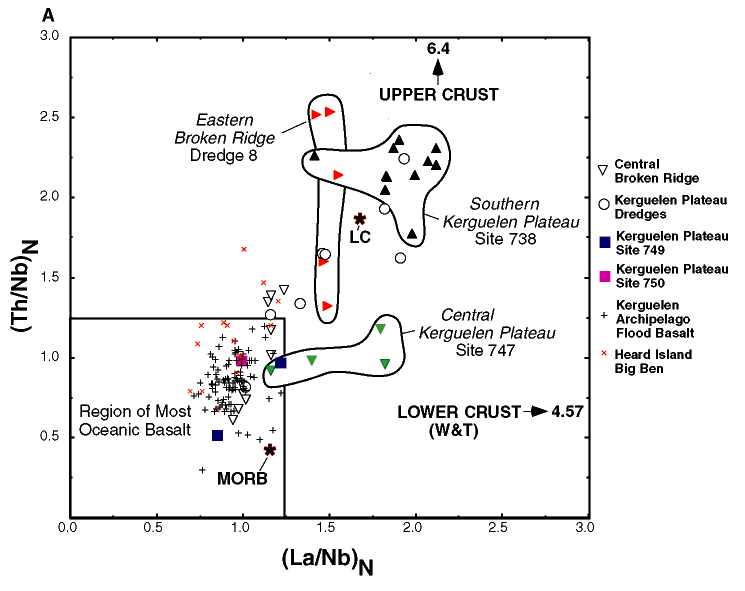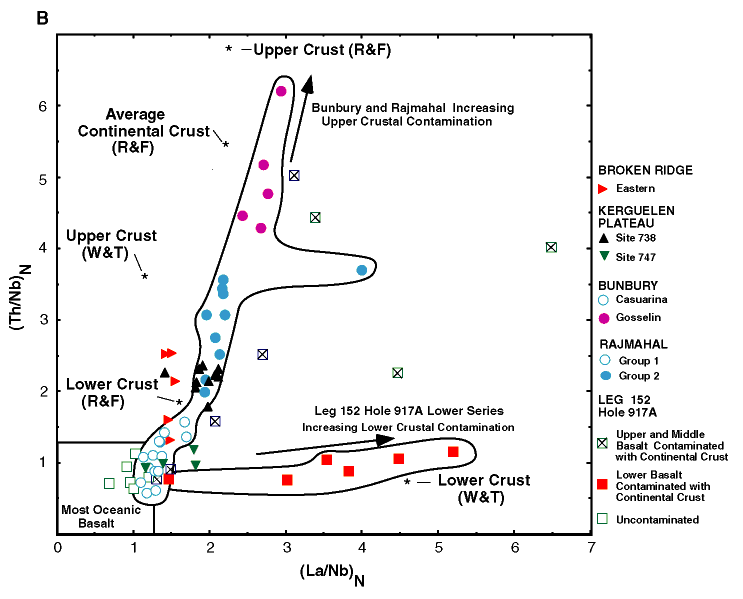Figure F11. A. Abundance ratios of (Th/Nb)N vs. (La/Nb)N (subscript N indicates ratios normalized to primitive mantle values of Sun and McDonough, 1989). Most oceanic island basalts, including ~100 basalts from the Kerguelen Archipelago, have (Th/Nb)N < 1 and (La/Nb)N = ~1. In contrast, most continental crust, especially upper crust, is relatively depleted in Nb (and Ta) (e.g., Thompson et. al., 1984) with (Th/Nb)N = 5.46 and (La/Nb)N = 2.17 in average bulk crust (calculated from Rudnick and Fountain, 1995, using revised Nb and Ta values of upper crust from Plank and Langmuir, 1998). As indicated, lower (LC) and upper crustal compositions differ considerably (averages of Rudnick and Fountain, 1995). Furthermore, estimates of lower crustal composition differ significantly; compare LC in the figure (based on Rudnick and Fountain, 1995) with the lower crustal value of Weaver and Tarney (1984) (W&T in figure). Dredge 8 basalts from eastern Broken Ridge and Kerguelen Plateau basalts from Site 738 and dredge basalts from the 77° graben (Kerguelen Plateau Dredges) lie outside the oceanic basalt field, thereby showing that they contain a continental crustal component, an inference consistent with isotope data (Figs. F7, F8). Also, Kerguelen Plateau samples from Site 747 are offset to high (La/Nb)N, but they have normal (Th/Nb)N; these basalts may have a smaller proportion of a different continental crustal component. Although all Kerguelen Archipelago flood basalts lie within the field for normal oceanic basalts, lavas of the Heard Island-Big Ben basaltic series trend to high (Th/Nb)N. This trend is accompanied by increasing 87Sr/86Sr (Fig. F9), and it is also a trend reflecting an increasing role for a continental crust component (Barling et al., 1994). Other data sources are Davies et al. (1989); Storey et al. (1992); Mahoney et al. (1995); Yang et al. (1998); Frey et al. (in press). B. Same plot as in A, but with an enlarged scale to include data for continental basalts that have been attributed to the Kerguelen plume, that is, the Bunbury Basalt (southwest Australia) and Rajmahal Basalt (northeast India). These basalts show a trend of variable contamination by a continental crust component (Frey et al. 1996; Kent et al., 1997). Estimates of average, upper, and lower continental crust are from Rudnick and Fountain (1995) and Weaver and Tarney (1984) and are labeled (R&F) and (W&T) in the figure. Also shown are North Atlantic MORBs recovered during Leg 152 in a transect away from Greenland. The lowermost lavas in Hole 917A, the drill site closest to Greenland, define a trend consistent with variable contamination by lower crustal granulites. In fact, Fitton et al. (1998a, 1998b) concluded that two different crustal components are present in lavas from Hole 917A; the oldest lavas contain a component derived from granulite-facies Archean crust, whereas some of the younger lavas contain a component derived from amphibolite-facies Archean crust. Relative to Kerguelen Plateau basalts, the much stronger continental signature in these North Atlantic MORBs probably reflects the lower abundances of incompatible elements in MORBs relative to plume magmas.


![]()